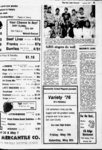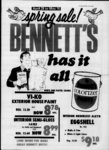| OCR Text |
Show Good tips to help your lawn along ANNUAL 1976 FARM GARDEN RANCH 29, April Record Juan San By MelvinS. Burningham Utah State University Extension Area Horticulturist Probably nothing enhances the appearance of our communities - more than thrifty, well-ke- pt lawns. We have a lot of them, but we also have some lawn problems. In hot summer weather we most often see a problem of a burned appearance in lawns resulting from drought. You can go down the streets and see about a third of the lawns that have drought problems caused Supplement The insufficient or improper irrigation. Soon after fertilizing you will need to water your lawn about every four or five days, and then as the grass becomes in the summer, once a week may be plenty often. This will vary with types of soil. Gravely or sandy soil will require more frequent irrigation than clay soil. Some lawns just look unthrifty. Often this is a result-o- f mowing too close. The only time we suggest mowing close is the first 'cutting in the spring. At that time you can lower the cutter bar on your by semi-dorma- nt Th(n Sami Juan (Record HOMETOWN NEWSPAPER FOR SAN JUAN COUNTY. UTAH 1 , mowing machine down to one-ha- lf inch to three-quarte- rs of an inch to cut off all the old dead stuff. Catch it and remove it. Then the new grass will come up green and nice. But after that first cutting, if you want a really healthy looking lawn raise the cutter bar about two inches. Leave (Please turn to page 15) $4 - CORNERS BULL SALE 12:30 P.M. MAY 3, 1976 Ag research holds key - agricultural research to increase food production in the past 50 years; and much can yet be done, asserts Dr. K. W. When I was doing work on my doctorate degree in Nebraska in 1950, the state of Illinois averaged 50 bushels of corn per acre. That was the first time any state had averaged that high. Now 25 years later, they are growing 100 bushels per acre in Illinois I would attribute and Iowa. this increase to plant breeding research and to management use of about five times as much fertilizer as before. Also, they have insect and weed control and more irrigation., One wonders what the end may be. I would expect that in the next 25 years production will probably go up about 50 percent. He noted that wheat and rice yields in many areas of the world are now double what they were but a few years ago. He said, " If someone had told including much-bette- r me when 1 (17 miles S.W. of Durango, 40 miles N. of Farmington) Colorado State University and the Four Corners Beef Cattle Improvement Association will sell 170 top performing bulls out of the 258 on test. Performance information available include weaning weights, yearling weights, feed efficiency, structural and breeding soundness. Only thoe bulls on test which have proven to be outstanding in these important economic traits will be eligible for sale. Bulls on test include: 175 Herefords 18 Red Angus 7 Maine-Anj- tural experiment stations. In- creasing food production in the future also depends on research. I cant see any other way. was an undergrad- Market ' Beans Wheat $13 $ 5 ing up on one acre of land. We probably cant go much higher than about 300 bushels per acre. We could do much to in NEW NEW NEW OFFSET DISC HARROW speeds stubble mulching, seedbed preparation. work wheeled type, designed for open field Leaves fields smooth and level, without furrows Sealed 6" x 10" gang frames which can be filled for extra weight el Dual wheels and hubs, Adjustable, self-leveli- 10V2" or 9" blade spacings linkage raises disc for easy transport ng Hydraulic lift Available in 8 widths, from 10V2' to 18' Scrapers adjustable and reversible for double wear life Polled Hereford 22 Angus 17 Simmental 7 Limousin 7 Red Brangus 1 many years. The USU plant science head stated, Many of the advancements in food production of the past were made possible through work of the agricul- uate that we would someday grow 150 bushels of wheat per acre, I would have told them that they were crazy. But it is being done quite regularly. Yields at that time were about 50 to 65 bushels per acre. Now, up to 2 50 -- bushel yields are obtained in small plots. I suppose there are biological limits since you can only have so many spears of whieat stick- box-ste- San Juan Basin Research Center Hesperus, Colorado ability to take nitrogen from the air, where there is plenty, and convert it into usable form for the plants could be incorporated into the three main crops: corn, wheat, and rice. Dr. Hill said, If genes that make this possible, such as those in alfalfa, could be introduced into corn, wheat and rice, it would cut down the need for nitrogen fertilizer by about 90 percent. Some additional plants are being found that have this ability. Some corn has been found in Brazil that has the ability to fix nitrogen from the atmosphere. The research challenge is to transfer those characteristics to other desirable corn plants by breeding. That is a long, tedious process requiring Hill, Head, Plant Science Department, Utah State University. As an example he said, Heavy-dut- y 27th ANNUAL PERFORMANCE TEST crease food yields and reduce fertilizer requirements if the Much has been done through 3 1 ou Charolais Shorthorn These bulls represent some of the top bulLs from 32 ranches over a 4 - state area, many of which have been performance testing for years. Bulls are on a 68 TDN growing ration consisting of 75 silage, which will adequately express -any genetic differences between bulls for rate and efficiency of gain during the 140 day test. Inspection of bulls, Sunday at 2 PM, May 2, sale May 3. Catalogs can be obtained by writing: A. H. Denham, Superintendent San Juan Basin Research Center Hesperus, Colorado 81326 Phone: Clcy (303)385-457- 4 or Jim Brinks Department of Animal Sciences Colorado State University Fort Collins, Colorado 80523 Phone: 1 70 (303)491-692- 8 SALE BULLS WE LL TAILOR MF FINANCING TO YOUR SPECIFIC NEEDS DENTONS INC. Pleasant View, Colo. V. |
































